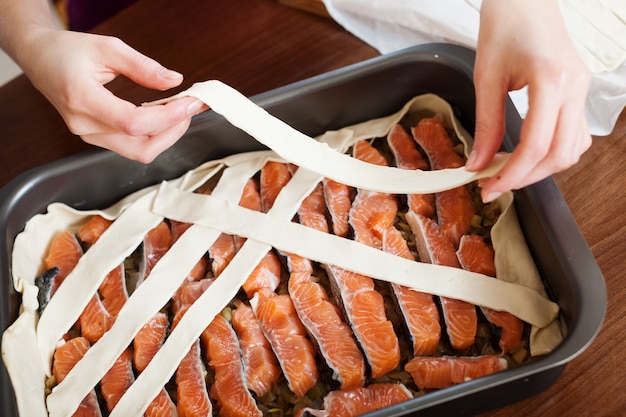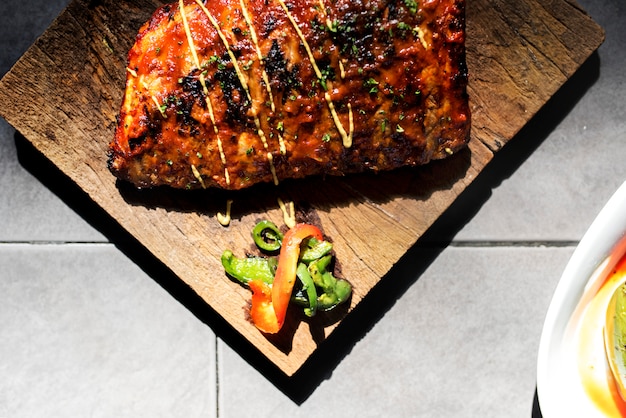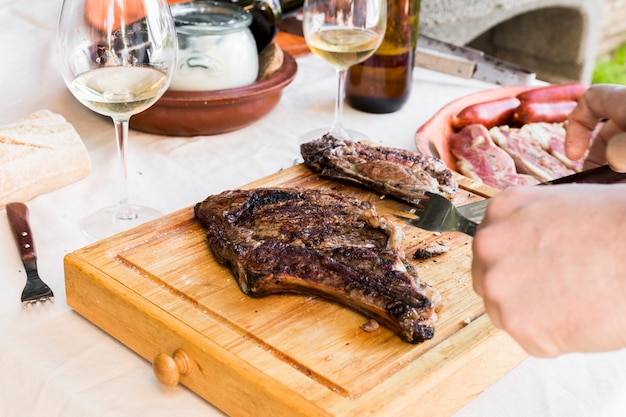There's a certain magic to ribs, isn't there? The smoky aroma, the melt-in-your-mouth tenderness, the crispy edges – it's the quintessential comfort food. But let's be real, cooking ribs can be a bit of a rollercoaster. One minute you're feeling confident, the next you're staring at a dry, tough piece of meat that makes you want to chuck the whole thing in the bin. I've been there, and trust me, it's not a good look.
Over the years, I've experimented with countless recipes, techniques, and oven temperatures. And I've learned a thing or two about what it takes to get those ribs perfectly juicy and tender. One of the most crucial factors? You guessed it – oven temperature. Get it right, and you're on your way to rib nirvana. Get it wrong, and well, let's just say you'll be reaching for the sauce to mask any dryness.
So, how do you find that sweet spot? Let's dive in, shall we?
(Part 1) The Low and Slow Approach: The Key to Tenderness

When it comes to ribs, the mantra is low and slow. You want to cook them at a gentle temperature, giving the meat ample time to break down and become super tender. We're talking about temperatures between 225°F (107°C) and 250°F (121°C). This might sound ridiculously low, but trust me, it's the secret to success.
Why the low and slow approach? Imagine it like this: at lower temperatures, the heat penetrates the meat more evenly, allowing it to cook through without drying out. You're essentially using time and patience to achieve maximum tenderness. It's a bit like a slow-cooked stew – the longer you simmer it, the more flavorful and tender it becomes.
Choosing the Right Oven Temperature: It's a Balancing Act
There's no one-size-fits-all number when it comes to oven temperature. It depends on a few key factors, including:
- The type of ribs you're using: Baby back ribs, known for their smaller size and more delicate flavor, cook faster than spare ribs, which are larger and meatier.
- Your preferred cooking method: smoking ribs typically requires a lower temperature than oven-baking.
- How much time you have: If you're short on time, a slightly higher temperature might be necessary.
For example, if you're using baby back ribs, you might opt for a slightly higher temperature, around 250°F (121°C). On the other hand, if you're dealing with a rack of spare ribs, 225°F (107°C) is probably a better choice, giving them ample time to break down and become incredibly tender.
The Pros and Cons: Weighing the Options
Let's break down the advantages and disadvantages of lower versus higher oven temperatures, so you can make an informed decision:
Lower Oven Temperature (225°F/107°C):
- Pros: More even cooking, less risk of drying out, incredibly tender results, ideal for spare ribs and those who have ample time.
- Cons: Longer cooking time, requires more patience, might require more frequent monitoring.
Higher Oven Temperature (250°F/121°C):
- Pros: Faster cooking time, good for smaller ribs, more convenient for those with limited time.
- Cons: Increased risk of drying out, might require extra attention, might not achieve the same level of tenderness as lower temperatures.
(Part 2) Ribs vs. Rib Tips: Understanding the Differences

Let's talk about the stars of the show: baby back ribs and spare ribs. Both are delicious, but they have their own unique characteristics that affect cooking times and oven temperatures.
Baby Back Ribs: The Delicate Choice
- These ribs are smaller and more tender, with less fat and a delicate flavour. They're the perfect choice for those who prefer a lighter, more refined taste.
- They cook faster than spare ribs and usually require a higher oven temperature, around 250°F (121°C).
- Because of their smaller size and less fat content, they can be a bit more susceptible to drying out, so it's crucial to monitor them closely.
Spare Ribs: The Meaty Option
- These ribs are larger and meatier, with more fat and a richer, bolder flavour. They're the perfect choice for those who love a hearty, meaty rib experience.
- They take longer to cook and benefit from a lower oven temperature, around 225°F (107°C). The extra fat helps keep them moist, even at lower temperatures.
- The longer cooking time allows the fat to melt and infuse the meat with incredible flavour, resulting in a truly succulent experience.
(Part 3) The Power of a meat thermometer: Your rib cooking Hero

Speaking of cooking times, it's important to remember that every oven and every rack of ribs is different. So relying solely on a set time can be a recipe for disappointment. That's where a trusty meat thermometer comes in.
I always use a meat thermometer to ensure my ribs are cooked to perfection. You want to aim for an internal temperature of 190°F (88°C) for fall-off-the-bone tenderness. But remember, it's all about finding your own perfect temperature. Some people like their ribs a little more cooked, while others prefer them slightly pink.
Why a Meat Thermometer is Essential: More than Just a Tool
- Ensures accurate cooking: A meat thermometer eliminates guesswork and ensures your ribs are cooked to your desired level of doneness. It's like having a culinary compass that guides you to the perfect destination.
- Prevents overcooking: It helps you avoid overcooking the ribs, which can lead to dryness and a disappointing texture. You wouldn't want to overcook a delicate piece of fish, and the same applies to ribs.
- Provides peace of mind: It gives you peace of mind knowing that your ribs are safe to eat and cooked to your exact preferences. It's like having a culinary insurance policy for your ribs.
(Part 4) Cooking Methods: Smoker vs. Oven - The Great Debate
There are two main ways to cook ribs: in a smoker or in the oven. Both methods have their own advantages and disadvantages, so the choice depends on your preferences and available equipment.
Smoker: The King of Smoky Flavor
Smoking ribs is a popular choice for those who want to achieve that classic, smoky flavour. A smoker uses wood chips to infuse the ribs with a unique flavour profile that's both complex and alluring. The slow cooking process also ensures incredibly tender meat, with a melt-in-your-mouth texture.
For smokers, the ideal temperature is usually between 225°F (107°C) and 250°F (121°C), but it's important to follow the manufacturer's instructions for your specific smoker. The magic of smoking lies in the slow, gentle heat that allows the wood smoke to permeate the meat, creating a unique and delicious flavour.
Oven: A Convenient Option for Delicious Ribs
oven-baked ribs are a great option for those who don't have a smoker or who are looking for a more hands-off approach. You can achieve delicious, tender ribs in your oven with a bit of creativity and a few simple techniques.
As mentioned earlier, 225°F (107°C) to 250°F (121°C) is the ideal range for oven-baked ribs. You can also add wood chips to your oven for a hint of smoke flavour, creating a beautiful aroma and a touch of smoky depth. If you're using a gas oven, you can place wood chips in a foil packet on the bottom rack. For an electric oven, try soaking the chips in water and placing them in a small pan on the bottom of the oven.
Oven vs. Smoker: A Comparative Table
Let's take a closer look at the key differences between smoker and oven cooking, so you can make an informed decision about which method is right for you:
| Feature | Smoker | Oven |
|---|---|---|
| Flavor | Intense smoky flavor, infused with the unique aroma of wood smoke | Mildly smoky flavor (optional), can achieve a smoky flavour with the use of wood chips |
| Tenderness | Incredibly tender, due to the slow and gentle cooking process | Very tender, particularly when cooked at lower temperatures |
| Time | Longer cooking time, typically 4-6 hours, allowing for maximum tenderness and flavour development | Shorter cooking time, typically 2-4 hours, depending on the oven temperature and the type of ribs |
| Effort | Requires more attention, monitoring the temperature and adding wood chips as needed | More hands-off, once the ribs are in the oven, they require less monitoring |
| Equipment | Requires a smoker, which can be a significant investment | Uses standard oven, readily available in most homes |
(Part 5) The Importance of Resting: Let the Ribs Relax
Once your ribs are cooked through, don't be tempted to dive in right away. Give them a good rest before carving and serving.
Why rest? It allows the juices to redistribute throughout the meat, resulting in even more tender and succulent ribs. It's like giving the ribs a spa treatment, allowing them to unwind and soak in all the delicious flavors they've absorbed during cooking.
You can wrap the ribs in foil and let them rest for 30 minutes to an hour. This creates a steamy environment that helps the meat retain moisture and tenderness. It's a crucial step for achieving the perfect rib experience.
Resting Ribs: The Benefits
- Helps retain moisture: Resting prevents the juices from escaping, resulting in more flavorful and tender ribs. It's like locking in all the deliciousness.
- Allows juices to redistribute: This ensures that the meat is evenly moist and tender, from edge to edge. It's like giving the ribs a massage to even out the flavor and moisture.
- Makes carving easier: Resting the ribs makes the meat more manageable to carve, reducing the risk of tearing or shredding the meat. It's like giving the ribs a bit of flexibility before they face the sharp edge of a carving knife.
(Part 6) The Perfect rib rub: Adding Flavor and Texture
No rib recipe is complete without a good rub. A dry rub is a blend of spices that you apply to the ribs before cooking. It adds flavor and helps to create a crispy bark on the ribs, creating a delightful contrast of textures.
I like to use a blend of paprika, brown sugar, garlic powder, onion powder, salt, and pepper. But you can experiment with different spices to create your own signature rub. The beauty of a rib rub is that it's a blank canvas for your creativity.
Tips for Applying a Rub: Getting it Right
- Pat the ribs dry: This helps the rub adhere better. You want the rub to cling to the meat, not slide off, so a dry surface is essential.
- Apply a generous layer: Don't be shy with the rub. A generous coating will infuse the ribs with delicious flavor and create a beautiful, crispy bark.
- Rub it in well: Make sure the rub is evenly distributed across the ribs. You want a consistent flavor and a beautiful, even bark.
(Part 7) The Finishing Touch: Sauce
While a good rub is essential, a delicious barbecue sauce is the perfect finishing touch. It adds another layer of flavor and moisture to the ribs, creating a harmonious symphony of tastes.
There are endless varieties of barbecue sauce, but I always keep a few favorites on hand. From sweet and smoky to tangy and spicy, there's a sauce for everyone. The best part? You can experiment with different sauces to find your perfect match.
Tips for Applying Sauce: Adding the Final Touch
- Don't overdo it: A little sauce goes a long way. You want to enhance the flavor, not drown the ribs in sauce.
- Apply it during the last 30 minutes of cooking: This helps to prevent the sauce from burning and allows it to caramelize, creating a beautiful, glossy finish.
- Brush it on generously: Ensure the sauce is evenly distributed across the ribs. You want every bite to be a delicious, saucy delight.
(Part 8) My Rib Journey: A Personal Touch
My rib journey has been a long one, filled with both successes and failures. I've learned that the key to perfect ribs is a combination of factors, including oven temperature, cooking time, and attention to detail. It's a journey of experimentation and discovery, a culinary adventure that's both rewarding and delicious.
I remember my first attempt at ribs – a disaster! The meat was dry, tough, and frankly, inedible. It was a culinary catastrophe. But I didn't give up. I researched, experimented, and eventually, I found my groove. I learned from my mistakes, and each time, I got a little closer to achieving rib perfection.
Now, I’m confident in my ability to create ribs that are tender, juicy, and bursting with flavour. And I know that you can too. Just remember to be patient, experiment, and most importantly, enjoy the process. It's a journey of culinary exploration, and the rewards are well worth the effort.
FAQs
1. What is the best way to tell if ribs are done?
The best way to tell if ribs are done is to use a meat thermometer. Aim for an internal temperature of 190°F (88°C). You can also check for tenderness by gently pulling on a bone. If the meat easily pulls away from the bone, they’re ready to go. It's a simple test that ensures you're not overcooking the ribs.
2. How long should I cook ribs in the oven?
The cooking time for ribs varies depending on the type of ribs, the oven temperature, and your desired level of doneness. However, as a general guideline, you can expect to cook ribs in the oven for 3 to 4 hours at 225°F (107°C) or 2 to 3 hours at 250°F (121°C). Remember, it's always best to use a meat thermometer to ensure the ribs are cooked to your liking.
3. Can I cook ribs on a lower temperature than 225°F (107°C)?
Yes, you can cook ribs at a lower temperature, but it will take longer. If you're looking for the most tender ribs possible, a lower temperature is often preferred. Just be prepared to commit to a longer cooking time and monitor the ribs closely.
4. What happens if I overcook ribs?
Overcooked ribs will be dry and tough. The meat will lose its moisture and become difficult to chew. If you overcook your ribs, try adding more sauce to add moisture and flavour. It's a bit like a culinary rescue mission for your ribs, but it's not the ideal situation.
5. What is the best way to store leftover ribs?
Leftover ribs can be stored in an airtight container in the refrigerator for up to 3 days. To reheat, you can microwave them or bake them in the oven. Microwaving will be quicker, but baking will help to retain the moisture and flavor. Enjoy your leftover ribs in sandwiches, salads, or just plain on their own!
Everyone is watching

Corn on the Cob: The Ultimate Guide to Perfectly Cooked Ears
Healthy MealsAh, corn on the cob. Just the name evokes images of sunny days, barbecues, and that sweet, juicy flavour that ...

Scallops: The Ultimate Guide to Perfect Cooking
Healthy MealsAh, scallops. Those delicate, sweet, and utterly delicious morsels of the sea. They hold a special place in my...

Spaghetti Squash: The Ultimate Guide to Cooking and Serving
Healthy MealsRemember that time you saw spaghetti squash at the supermarket, looking all bumpy and strange, and thought, "W...

Salmon Cooking Times: Perfect Guide for Every Recipe
Healthy MealsLet me tell you, cooking salmon is an art form. It's all about getting that perfect balance: juicy and tender,...

Ham Cooking Time: How Long to Bake, Smoke, or Boil a Delicious Ham
Healthy MealsAh, ham. It's a classic, isn't it? A real crowd-pleaser, especially around holidays. And when done right, it'...
